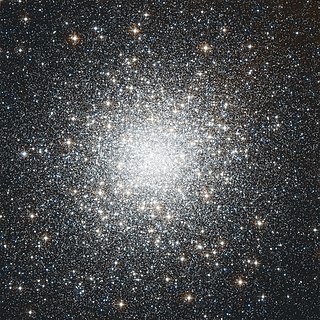
A globular cluster is a spheroidal conglomeration of stars that is bound together by gravity, with a higher concentration of stars towards its center. It can contain anywhere from tens of thousands to many millions of member stars, all orbiting in a stable, compact formation. Globular clusters are similar in form to dwarf spheroidal galaxies, and the distinction between the two is not always clear. Their name is derived from Latin globulus. Globular clusters are occasionally known simply as "globulars".

Messier 62 or M62, also known as NGC 6266 or the Flickering Globular Cluster, is a globular cluster of stars in the south of the equatorial constellation of Ophiuchus. It was discovered in 1771 by Charles Messier, then added to his catalogue eight years later.
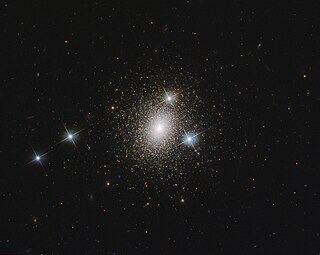
Mayall II, also known as NGC-224-G1, SKHB 1, GSC 2788:2139, HBK 0-1, M31GC J003247+393440 or Andromeda's Cluster, is a globular cluster orbiting M31, the Andromeda Galaxy.
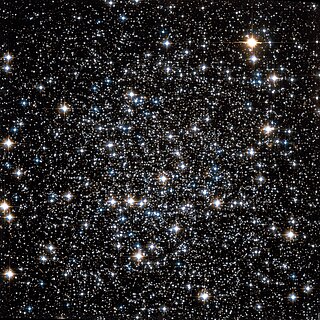
NGC 288 is a globular cluster in the constellation Sculptor. Its visual appearance was described by John Dreyer in 1888. It is located about 1.8° southeast of the galaxy NGC 253, 37′ north-northeast of the South Galactic Pole, 15′ south-southeast of a 9th magnitude star, and encompassed by a half-circular chain of stars that opens on its southwest side. It can be observed through binoculars. It is not very concentrated and has a well resolved, large 3′ dense core that is surrounded by a much more diffuse and irregular 9′ diameter ring. Peripheral members extend farther outward towards the south and especially southwest.

NGC 6752 is a globular cluster in the constellation Pavo. It is the fourth-brightest globular cluster in the sky, after Omega Centauri, 47 Tucanae and Messier 22, respectively. It is best seen from June to October in the Southern Hemisphere.

NGC 1851 is a relatively massive globular cluster located in the southern constellation of Columba. Astronomer John Dreyer described it as not very bright but very large, round, well resolved, and clearly consisting of stars. It is located 39.5 kilolight-years from the Sun, and 54.1 kilolight-years from the Galactic Center. The cluster is following a highly eccentric orbit through the galaxy, with an eccentricity of about 0.7.

Palomar 6 is a loose globular cluster in the constellation Ophiuchus that belongs to the Milky Way galaxy. It is a member of the Palomar Globular Clusters group. It is located about 25,000 light-years away from the Sun. It formed in what would become the bulge of the Milky Way. It is similar to other old-bulge globular clusters such as Messier 62, NGC 6522, NGC 6558, and Haute-Provence 1.
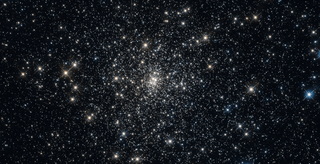
NGC 6256 is a globular cluster of stars in the southern constellation of Scorpius. It was discovered by the Scottish astronomer James Dunlop on Aug 2, 1826. In J. L. E. Dreyer's New General Catalogue annotation it is described as, "very faint, very large, very gradually bright in the middle, well resolved clearly consisting of stars." The cluster is located at a distance of 22 thousand light-years (6.8 kpc) from the Sun.

NGC 6441, sometimes also known as the Silver Nugget Cluster, is a globular cluster in the southern constellation of Scorpius. It was discovered by the Scottish astronomer James Dunlop on May 13, 1826, who described it as "a small, well-defined rather bright nebula, about 20″ in diameter". The cluster is located 5 arc minutes east-northeast of the star G Scorpii, and is some 43,000 light-years from the Sun.

NGC 330 is an open cluster in the Small Magellanic Cloud. It is located in the constellation Tucana. It was discovered on 1 August 1826 by James Dunlop. It was described by Dreyer as "a globular cluster, very bright, small, a little extended, stars from 13th to 15th magnitude." At an aperture of 31.0 arcseconds, the apparent V-band magnitude is 9.60, but at this wavelength, it also has 0.36 magnitudes of interstellar extinction.
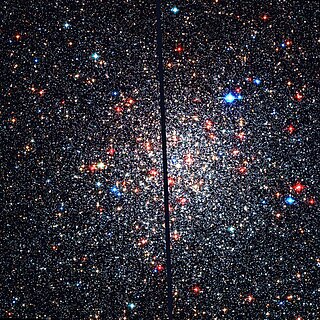
NGC 6553 is a globular cluster in the constellation Sagittarius. NGC 6553 has an apparent magnitude of about 8th magnitude with an apparent diameter of 8.2 arcminutes. Its Shapley–Sawyer Concentration Class is XI, meaning the star concentration is very loose even at the center; it has stars of magnitude 20 and dimmer. It is located just over a degree southeast of Messier 8, the Lagoon Nebula.
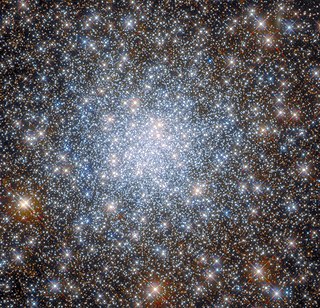
NGC 6638 is a globular cluster in the constellation Sagittarius. It is magnitude 9.5 and diameter 2 arc minutes, class VI. It is a half degree east of Lambda Sagittarii. It is a member of the Milky Way.

NGC 5634 is a globular cluster in the constellation Virgo (constellation), located about 82,200 light years away. NGC 5634 has an apparent magnitude of about 10 and a diameter of 4 or 5 arcminutes. Its Shapley–Sawyer Concentration Class is IV, meaning the cluster shows intermediate rich concentrations. The star near the upper right is the eleventh-magnitude UCAC2 29844847. There is also a bright orange giant, HD 127119, about 1.3 arcminutes away from the cluster.

NGC 6535 is a globular cluster of stars located at a distance of 22,200 light years from Earth in the equatorial constellation of Serpens, and is listed in the New General Catalogue. Its discovery is usually attributed to astronomer John Russell Hind in 1852, however Wolfgang Steinicke has uncovered evidence that William Herschel's first discovery was actually NGC 6535, which he observed on 24 August 1780.
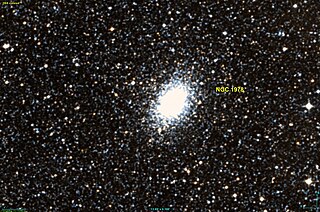
NGC 1978 is an elliptical shaped globular cluster or open cluster in the constellation Dorado. It is located within the Large Magellanic Cloud. It was discovered by James Dunlop on November 6, 1826. At an aperture of 50 arcseconds, its apparent V-band magnitude is 10.20, but at this wavelength, it has 0.16 magnitudes of interstellar extinction. It appears 3.9 arcminutes wide. NGC 1978 has a radial velocity of 293.1 ± 0.9 km/s.

NGC 3311 is a super-giant elliptical galaxy located about 190 million light-years away in the constellation Hydra. The galaxy was discovered by astronomer John Herschel on March 30, 1835. NGC 3311 is the brightest member of the Hydra Cluster and forms a pair with NGC 3309 which along with NGC 3311, dominate the central region of the Hydra Cluster.

NGC 4636 is an elliptical galaxy located in the constellation Virgo. It is a member of the NGC 4753 Group of galaxies, which is a member of the Virgo II Groups, a series of galaxies and galaxy clusters strung out from the southern edge of the Virgo Supercluster. It is located at a distance of about 55 million light years from Earth, which, given its apparent dimensions, means that NGC 4636 is about 105,000 light years across.

NGC 1381 is a lenticular galaxy located in the constellation Fornax. It is located at a distance of about 60 million light years from Earth, which, given its apparent dimensions, means that NGC 1381 is about 55,000 light years across. It is a member of the Fornax Cluster. NGC 1381 appears edge-on and features a thin disk with high surface brightness and a boxy bulge. Both the box-shaped bulge and the kinematics of the central area of the galaxy suggest that NGC 1381 has a bar.

NGC 7492 is a globular cluster in the constellation Aquarius. It was discovered by the astronomer William Herschel on September 20, 1786. It resides in the outskirts of the Milky Way, about 80,000 light-years away, more than twice the distance between the Sun and the center of the galaxy, and is a benchmark member of the outer galactic halo. The cluster is immersed in, but does not kinematically belong to, the Sagittarius Stream.
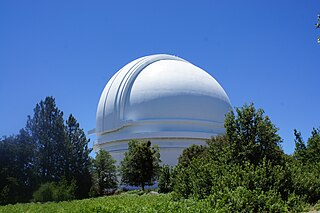
The Palomar globular clusters are some of the faintest of all globular clusters in the Milky Way galaxy, and been discovered in the 1950s on the survey plates of the first Palomar Observatory Sky Survey (POSS). In total there are 15 Palomar globular clusters, which include Palomar 1, Palomar 2, Palomar 3, Palomar 4, Palomar 5, Palomar 6, Palomar 7, Palomar 8, Palomar 9, Palomar 10, Palomar 11, Palomar 12, Palomar 13, Palomar 14, and Palomar 15. Some Palomar Globulars, like Palomar 6, Palomar 7, Palomar 9, Palomar 10 and Palomar 11 are clusters of average size located nearby, yet obscured in our line of sight by dust. Other Palomar globulars, like Palomar 3, Palomar 4 and Palomar 14 are giants located in the far outer halo of the Milky Way. Some even originated from a different galaxy, such as Palomar 12 from the Sagittarius Dwarf Spheroidal Galaxy, which is now known as a satellite of the Milky Way. Observation of different Palomar globulars greatly varies in the degree of difficulty depending on the cluster. Some are small and compact, others are very sparse, to the point where they may be hard to distinguish from foreground stars.




















